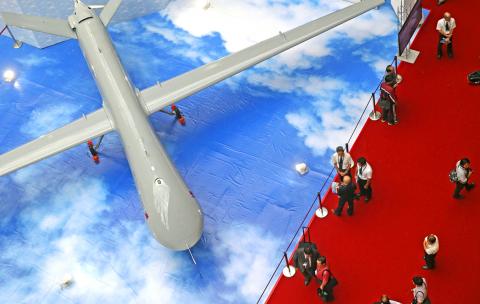Aerospace Industrial Development Corp (AIDC, 漢翔航空工業), the nation’s largest civilian and military aircraft manufacturer, yesterday demonstrated two new prototype trainer jets at a Taipei aerospace trade fair in a move to show its resolve in vying for the Republic of China Air Force’s NT$69 billion (US$2.1 billion) project to upgrade its aging fleet of 66 trainer aircraft.
The two new advanced trainer jets — the XAT-5, a stripped-down variant of the F-CK1, and the AT-3MAX, an upgraded variant of the aging AT-3 featuring revamped radar systems and an improved engine — were on display at the biennial Taipei Aerospace and Defense Technology Exhibition, which began yesterday.
In response to rumors that the armed forces might be favoring the Italian-built M-346 trainer, AIDC chairman Anson Liao (廖榮鑫) said President Ma Ying-jeou (馬英九) had pledged that even if the procurement deal fell to a foreign bidder, the aircraft would still be built in Taiwan.

Photo: AP
AIDC is also facing competition from the South Korean-built T-50.
“Given AIDC’s track record of building and designing the indigenously developed F-CK1s and AT-3 trainer jets, the company is the ideal choice to build the nation’s next generation of trainer aircraft,” said Liao, a former air force pilot.
The deal is crucial for AIDC, as it is expected to yield revenue of NT$200 billion for parts and maintenance over their service life spanning the next two decades, Liao said.
However, with delivery of the jets to begin in 2019, the armed forces has not indicated a clear timetable for AIDC, Liao said.
“Uncertainties remains in the Ministry of National Defense’s final decision on combat specifications and budget, but AIDC is fully capable of overcoming all technical challenges,” he said.
AIDC is pushing for at least 50 percent domestic production for the next-generation aircraft, although it is difficult to gauge what the air force’s decision will be regarding the training aircraft, Liao said.
“If the goal is to train our pilots for the Lockheed Martin F-35, a certain type of trainer jet would be required, while other fighters require different training aircraft,” he said.
Seperately, Yuanta Securities Investment Consulting Co (元大投顧) said AIDC would not be affected by Lockheed Martin’s acquisition of Sikorsky, a major client of the Taiwanese firm with a 6 percent revenue contribution last year.
“In addition, the company has broken into the supply chain for the China-built C919, making company immune to competition between the Airbus A320 and the Boeing B737 short-to-medium range narrow-body airliner,” Yuanta analyst Livia Wu (吳靚芙) said in a report on Wednesday, adding that she is positive over AIDC’s commercial aircraft and general aviation businesses.
Last quarter, AIDC recorded net income of NT$444.6 million, or NT$0.49 per share, on sales of NT$6.9 billion. Net income in the first half came to NT$868 million, or NT$0.95 per share, on sales of NT$12.8 billion.
AIDC shares gained 0.27 percent to close at NT$37.65 in Taipei trading yesterday.

The US dollar was trading at NT$29.7 at 10am today on the Taipei Foreign Exchange, as the New Taiwan dollar gained NT$1.364 from the previous close last week. The NT dollar continued to rise today, after surging 3.07 percent on Friday. After opening at NT$30.91, the NT dollar gained more than NT$1 in just 15 minutes, briefly passing the NT$30 mark. Before the US Department of the Treasury's semi-annual currency report came out, expectations that the NT dollar would keep rising were already building. The NT dollar on Friday closed at NT$31.064, up by NT$0.953 — a 3.07 percent single-day gain. Today,

‘SHORT TERM’: The local currency would likely remain strong in the near term, driven by anticipated US trade pressure, capital inflows and expectations of a US Fed rate cut The US dollar is expected to fall below NT$30 in the near term, as traders anticipate increased pressure from Washington for Taiwan to allow the New Taiwan dollar to appreciate, Cathay United Bank (國泰世華銀行) chief economist Lin Chi-chao (林啟超) said. Following a sharp drop in the greenback against the NT dollar on Friday, Lin told the Central News Agency that the local currency is likely to remain strong in the short term, driven in part by market psychology surrounding anticipated US policy pressure. On Friday, the US dollar fell NT$0.953, or 3.07 percent, closing at NT$31.064 — its lowest level since Jan.

The New Taiwan dollar and Taiwanese stocks surged on signs that trade tensions between the world’s top two economies might start easing and as US tech earnings boosted the outlook of the nation’s semiconductor exports. The NT dollar strengthened as much as 3.8 percent versus the US dollar to 30.815, the biggest intraday gain since January 2011, closing at NT$31.064. The benchmark TAIEX jumped 2.73 percent to outperform the region’s equity gauges. Outlook for global trade improved after China said it is assessing possible trade talks with the US, providing a boost for the nation’s currency and shares. As the NT dollar

PRESSURE EXPECTED: The appreciation of the NT dollar reflected expectations that Washington would press Taiwan to boost its currency against the US dollar, dealers said Taiwan’s export-oriented semiconductor and auto part manufacturers are expecting their margins to be affected by large foreign exchange losses as the New Taiwan dollar continued to appreciate sharply against the US dollar yesterday. Among major semiconductor manufacturers, ASE Technology Holding Co (日月光), the world’s largest integrated circuit (IC) packaging and testing services provider, said that whenever the NT dollar rises NT$1 against the greenback, its gross margin is cut by about 1.5 percent. The NT dollar traded as strong as NT$29.59 per US dollar before trimming gains to close NT$0.919, or 2.96 percent, higher at NT$30.145 yesterday in Taipei trading